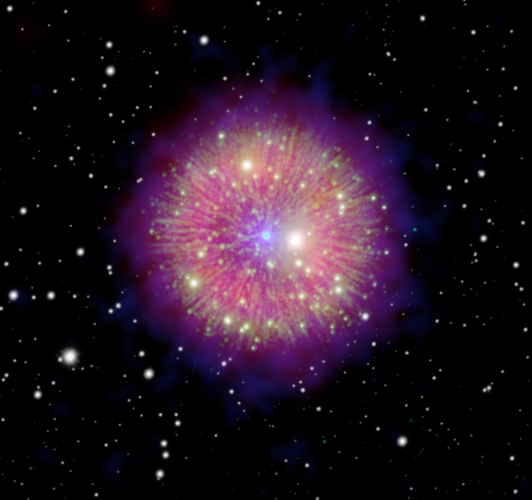In the year 1181 a rare supernova explosion appeared in the night sky, staying visible for 185 consecutive days. Historical records show that the supernova looked like a temporary ‘star’ in the constellation Cassiopeia shining as bright as Saturn.
Ever since, scientists have tried to find the supernova’s remnant. At first it was thought that this could be the nebula around the pulsar (dead star) 3C 58. However closer investigations revealed that the pulsar is older than supernova 1181.
In the last decade, another contender was discovered; Pa 30 is a nearly circular nebula with a central star in the constellation Cassiopeia. It is pictured here combining images from several telescopes. This composite image uses data across the electromagnetic spectrum and shows a new spectacular view of the supernova remnant. Allowing us to marvel at the same object that appeared in our ancestors’ night sky more than 800 years ago.
X-ray observations by ESA’s XMM-Newton (blue) show the full extent of the nebula and NASA’s Chandra X-ray Observatory (cyan) pinpoints its central source. The nebula is barely visible in optical light but shines bright in infrared light, collected by NASA’s Wide-field Infrared Space Explorer (red and pink). Interestingly, the radial structure in the image consists of heated sulphur that glows in visible light, observed with the ground-based Hiltner 2.4 m telescope at the MDM Observatory (green) in Arizona, USA, as do the stars in the background by Pan-STARRS (white) in Hawaii, USA.
Studies of the composition of the different parts of the remnant have led scientists to believe that it was formed in a thermonuclear explosion, and more precisely a special kind of supernova called a sub-luminous Type Iax event. During this event two white dwarf stars merged, and typically no remnant is expected for this kind of explosion. But incomplete explosions can leave a kind of ‘zombie’ star, such as the massive white dwarf star in this system. This very hot star, one of the hottest stars in the Milky Way (about 200 000 degrees Celsius), has a fast stellar wind with speeds up to 16 000 km/h. The combination of the star and the nebula makes it a unique opportunity for studying such rare explosions.
[Image description: A composite image of the remnant of supernova 1181. A spherical bright nebula sits in the middle surrounded by a field of white dotted stars. Within the nebula several rays point out like fireworks from a central star.]



 Image:
Image: